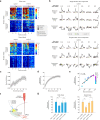Fast updating feedback from piriform cortex to the olfactory bulb relays multimodal identity and reward contingency signals during rule-reversal
- PMID: 39843439
- PMCID: PMC11754465
- DOI: 10.1038/s41467-025-56023-5
Fast updating feedback from piriform cortex to the olfactory bulb relays multimodal identity and reward contingency signals during rule-reversal
Abstract
While animals readily adjust their behavior to adapt to relevant changes in the environment, the neural pathways enabling these changes remain largely unknown. Here, using multiphoton imaging, we investigate whether feedback from the piriform cortex to the olfactory bulb supports such behavioral flexibility. To this end, we engage head-fixed male mice in a multimodal rule-reversal task guided by olfactory and auditory cues. Both odor and, surprisingly, the sound cues trigger responses in the cortical bulbar feedback axons which precede the behavioral report. Responses to the same sensory cue are strongly modulated upon changes in stimulus-reward contingency (rule-reversals). The re-shaping of individual bouton responses occurs within seconds of the rule-reversal events and is correlated with changes in behavior. Optogenetic perturbation of cortical feedback within the bulb disrupts the behavioral performance. Our results indicate that the piriform-to-olfactory bulb feedback axons carry stimulus identity and reward contingency signals which are rapidly re-formatted according to changes in the behavioral context.
© 2025. The Author(s).
Conflict of interest statement
Competing interests: The authors declare no competing interests.
Figures





Update of
-
Fast updating feedback from piriform cortex to the olfactory bulb relays multimodal reward contingency signals during rule-reversal.bioRxiv [Preprint]. 2023 Sep 13:2023.09.12.557267. doi: 10.1101/2023.09.12.557267. bioRxiv. 2023. Update in: Nat Commun. 2025 Jan 22;16(1):937. doi: 10.1038/s41467-025-56023-5. PMID: 37745564 Free PMC article. Updated. Preprint.
References
-
- Chklovskii, D. B. & Koulakov, A. A. Maps in the brain: what can we learn from them? Annu. Rev. Neurosci.27, 369–392 (2004). - PubMed
MeSH terms
Grants and funding
LinkOut - more resources
Full Text Sources

